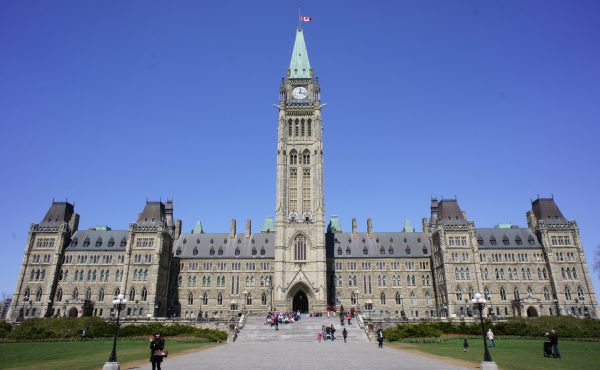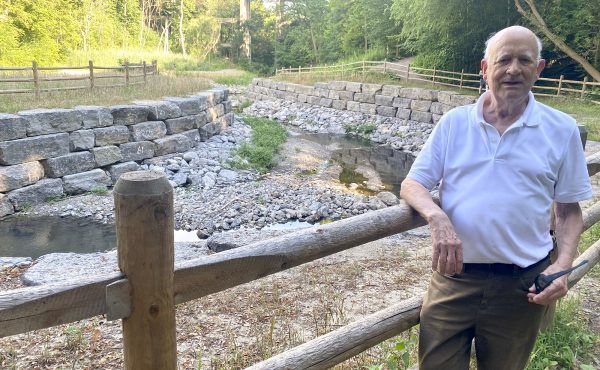
The above graphic might look like the cover of an Isaac Asimov book, but its actually noted west coast architect Richard Henriquez’s proposal for an observation tower in Vancouver’s Queen Elizabeth Park. The park used to be the city’s premiere vantage point to look out over the growing metropolis and surrounding mountains, but those pesky things called trees have grown up and now block most of the sight lines.
Gordon Price, the director of Simon Fraser University’s Cities Program, says on his blog, “There’s just something about getting to a high place with long views that’s embedded in our genes. And they’re great places to take visitors to explain the lay of the land. They give us another perspective on our own place.”
I began contemplating a similar train of thought after reading an interview in the book Concrete Toronto with Macy DuBois, one of the architects on a team that was a runner-up in the New City Hall design competition of 1957-58 (he was a student at the time and entered with fellow student John Andrews, who would become the architect behind U of T’s Scarborough campus and the CN Tower). DuBois said he felt New City Hall should be low to the ground because, “I hate high-rises. I feel they detach people from the ground and their surroundings.” That notion was certainly reflected in his submission (below).
I’ve had the complete opposite reaction to living on the 24th floor of a high-rise in south Parkdale. I feel much more connected to the ground and my surroundings: because I can see so far off into the distance, I’m constantly humbled by the size and scope of the city and my view of the western edge of Lake Ontario; I watch the sunset every day, a difficult task from the ground in flat Toronto; The cycles of the moon are part of my nights, and I can confidently predict the path of the moon; I watch storms roll in across from the west over Hamilton or Oakville (handy during the fall and spring when you never know if its going to rain); I also get to watch people go about their lives (steering boats on the lake, strolling along the waterfront boardwalk, riding bikes on the Martin Goodman Trail, throwing rocks from the beach at Sunnyside, driving on and off the Gardiner Expressway). Not only do I get see those things each day, I’m usually doing something similar when at ground level.
The height of my apartment often gives me pause for thought about the complexity of society and civilization. I understand the feeling of DuBois and many of the disciples of low-rise development have towards tall buildings, but we also need to appreciate the value a high-rise — or in Vancouver’s sake an observation tower — can add to the human experience.





19 comments
When I was living on the 19th floor at St. Clair and Yonge I felt more connected to the rest of Toronto than I have since. I saw it all at one glance. I wrote about exactly this in the first uTOpia volume.
Sometimes I think people who hate condos or highrises have never lived in one and are basing their feeling on some kind of ideology.
Also the great Macy DuBois died the other day, RIP.
. . .Gordon Price, the director of Simon Fraser University’s Cities Program, says on his blog, “There’s just something about getting to a high place with long views that’s embedded in our genes. And they’re great places to take visitors to explain the lay of the land. They give us another perspective on our own place.†. . .
—————
The high places with long views in Vancouver are from the north shore. They are jaw-dropping in their magnificence. There’s no need of a tower in a park; just an easy way to get to a natural elevated vantage point. After all, Montreal has its mountain and Toronto has Gallows hill and the Spadina rise.
Living in a high rise, is amazing and urban.
“Sometimes I think people who hate condos or highrises have never lived in one and are basing their feeling on some kind of ideology.”
I think this comes partly from Canadian expectations of space and environment. Many of the resident’s of Toronto have grown up with the expectations of a single family home. So until, as you mention, they live the experience, they don’t see the value, and therefore you get countless people costing valuable time and money to make a 36 storey tower a 34 storey tower, money that could be spent on better building materials or public realm instead.
That being said the Henriquez observation tower looks like a trashy version of Calatrava’s communication spire in Barcelona.
My experience in high rises left me feeling like if someone, say a giant in the sky (let’s call them God), were to reach down and pull the side of the building off to reveal the inner skin, would reveal that inside the grid the tenant-people were all mimicking each other’s actions. That is, as I went to pee, so did everybody else. Ditto for cutting carrots and watching tv.
Maybe it all stems from the sterile intimacy of fourteen storey elevator rides, but I found life in tall buildings dehumanizing, futher exacerbated by the idea that once I closed the door to my unit, I was sealed off from these people, though still able to look out my window and down on the world below. A view I came to reflect on as the God Perspective. These days, I prefer to live my life closer to the ground, where I can look the world in the eye.
I have no doubt that living in a high rise can be a wonderful experience (witness the folks lining up for days for a chance to buy a spot in what will be the highest high-rise in Toronto at 1 Bloor East). There is of course the other side of that particular coin: those of us wishing to enjoy the public realm at the feet of these towers.
It may be that the problem comes from tower designers focusing on, well, the tower and not how it meets the ground or how it can engage and enhance the linear public parks that are supposed to be our streets.
I have no problem with towers as monumental place makers, skyline builders, density sponges and high perch aerie for those who live there. What I do have a problem with is when these towers are designed in a way that creates dead zones at grade. I’d say that Cityplace and North York along Yonge Street are examples of this. Despite housing lots of people downtown these towers have not created a vibrant street life.
Because towers loom large in the visual landscape of the city I’d hope that they would also embrace a larger sense of responsibility to give back to the social landscape of the city.
Arguably we should be de-concentrating the high-rises in the core to – gasp – the middle of stable residential areas to improve densities there and the overall energy efficiencies of the city. Scale matters of course, and we likely need to tweak how we construct the buildings in a social sense.
But having a skyscape is great as can be the view of all the trees.
I divide my team equally between two highrises – my 11th floor bachelor pad in a featureless “commie block”, and my girlfriend’s 41st floor condo in the Buck Rogers-like Residences of College Park.
On one hand, I like the bright, unit-spanning windows that let the light kiss every corner of my unit, and I appreciate the straight walls…something that’s missing from living in hastily converted Edwardian house rentals. On the other hand, will the city please institute a green bin program? I weep every time I dump organic trash down the chute. At street level, I’m also less convinced that high rises are the way to go, not because they’re tall, but because planning and our patriarchal fire code demand that huge turning lanes and gaping garage door entranceways be built where, you know, public space could normally thrive.
What will happen to high-rises as energy costs go up? Will the operation of the building mechanicals be affordable? Will there be a lot of ghost towers in the sky?
Charles, a brief moment of thought on the matter would reveal that highrises are far more energy efficient than, say, single family houses. Your question should be “What will happen to low-density development as energy costs go up?”
I agree wholeheartedly with the otherwise intelligent comments on this page. High-rises are fantastic, and their views are intoxicating for the urban resident. They do have huge issues at ground level that are rarely successfully resolved. More attention need to be paid to permitting taller buildings and how to ensure that they work at street level, both from within the architectural profession and the development industry, and by the zoning and regulatory bodies that can all but guarantee bad results.
In her post earlier this week Amber Yared discussed how hidden parking often influences how the things we see get built.
The first 15 feet of skyscrapers are the missing link, the location of the big modern screw-up. If that part was fixed, and or built better in the future, lovers of streetscapes could continue to love and just choose not to look up, and building could go higher without as much opposition.
I think of so many streets in Manhatten with big and tall skycrapers built before the car, and they are perfectly urban and the sidewalk flow is continuous.
There are examples in Toronto where the parking requirements were placed in a way that preserves a fairly good urban flow — that condo where Roots and etc is housed at Bloor and Bellair is fairly good.
I am a strong believer in the advatages of high rise, especially in TO’s strongly supportive soil conditions. Socially a great deal could be gained from building ‘UP’ if a few simple considerations were acted upon.
Tall buildings should be subject to ‘different’ bylaws:
– a building over 10 floors (30m.) must maintain 60% of its site as publically accessable landscaped ‘parkland’.
– a building over 15 floors (45m) must also have only minimal Lobby, access, and stairway floor spaces for the first 4 floors (12m) before beginning normal floor plans, hence allowing light and air to envelope the public space below.
– all residential complexes (somewhat unrelated) must have accommodations suited to ‘mixed’ demographic groups including, but not restricted to some (10%) subsidized, or ‘affordable’ units.
We have limited ground space in the City, and limited easy access to parkland. Thus any solutions that maximize both, in an intelligent sustainable manner, are welcome.
The basic equation in high-rise views is that the fantastic view for those living in the highrise is paid for by the potential obstruction of view for everyone who does not live in the highrise but has to look at it.
Visually, it’s a benefit for a few, but a potential detriment for the many.
This doesn’t mean we shouldn’t have high-rises, but rather that, in visual terms, high-rises need to justify themselves by showing they are creating a better view for those who do not live in them.
So, for example, Toronto’s bank towers, all well-designed by noted architects, used to make an impressive skyline (before they were partially screened by walls of mostly mediocre condo buildings). Likewise, the “Marilyn Monroe” tower slated for Missisauga might make views in the city more interesting.
But clusters of mediocre and repetitive condo towers without a strong overall concept, such as Cityscape, are harder to justify visually. Views from the ground should definitely be taken into account when deciding whether a tall building should be allowed.
In exchange for the privilege of great views for those inside, tall buildings need to demonstrate they are making particular efforts to enhance the views of those outside looking at them.
I am talking here purely in visual terms – other issues (density, urban environment) also play in, but that’s a whole article in itself.
“all buildings should be subject to ‘different’ bylaws:
– a building over 10 floors (30m.) must maintain 60% of its site as publically accessable landscaped ‘parkland’.”
I like parks, but I don’t like “towers in a park”. Even where the landscaped grounds around highrises are publicly accessible, few have ever used these grounds as leisure space, whether this is in Toronto, New York or Paris. I’d much rather have a continuous streetwall with buildings that came right up to the sidewalk than have this decidedly suburban compromise.
I still don’t understand the thrill of a condominium except that it is a “cheap” alternative to a house. I guess seeing those crappy condos in moscow reminds me just how easily we can destroy this city by forgetting the street level activity.It’s easy to say look at the great view but it just seems there are few condo projects that create neighborhoods.The streetscape around the buildings are dismal to say the least.But then again I was born in Toronto and it’s hard to see the city you love treated with such disrespect.
My 7th floor apartment would have a nice view, if it wasn’t for the apartment building 100 metres away in the adjacent lot. The lack of privacy means that my balcony is rarely used.
In the years that I lived in high rises, I was always conscious of being enclosed in my own little Kleenex box in the sky, surrounded above, below, and on all sides by others in their own little boxes. Made me feel claustrophobic. I almost never ran into my neighbours, adding to the sense of isolation. I wonder if a cozy lounge on each floor would be used by the residents? These could be much more intimate then the seldomly used party rooms. Condos and high end apartment buildings at least could offer attractive spaces for the tenants/owners.
Though I didn’t enjoy living in high rises (my intense fear of heights might also have something to do with that 🙂 ), I have nothing against them from the outside, at ground level, when they have welcoming street level design (unfortunately, almost never). But I’m disappointed that in all the talk about high rises, mid-rise buildings keep getting vilified. For all the places in Toronto where a high rise would be appropriate, there are probably five other places where a well designed mid rise building would be a great improvement over the current mishmash of residential-turned-commercial buildings: little Victorian semis with storefronts carved into them, or flat, featureless additions tacked onto their fronts. Lots of room for intensification there too. If we throw all our intensification eggs into a small handful of baskets, will the sidewalks, transit, and other public spaces in those neighbourhoods be ready for the influx of new residents?
High rises have the potential for substantial contribution to balance their energy costs due to their attributes, allied with the scale to use projects out of reach for single family homes. For example:
* rooftop wind turbines (wind speeds way higher up there as anyone who’s been up CN Tower knows)
* solar panels could be placed in the (non-northfacing) floor and wall structure, the outside of balconies and on exposed concrete (I pass an apartment block at O’Connor and Woodbine crying out for this, not to mention all these lakeshore condos whose views are never likely to be obstructed)
* geothermal pipes buried under the required greenspace
* biodigestion of waste onsite rather than direct release to sewers – the digested remnant could be discharged at night when normal sanitary sewer flows are low. The gas could preheat water or add to preheating supplied by solar water heaters.
Hey Mark good try at the possibility of environmental measures, but if you have ever dealt with city hall you will find that solar panels on the building aren’t necessary.The hydro building at university and college is a great example of a building that uses solar power and human heat to keep the climate at comfortable levels.
As for geothermal heating Joe Pantalone doesn’t want that implemented until he can get credit for allowing those systems in toronto.He has announced that the exibition place will have such an installation.However my proposal to allow residential use is still a dead issue for the city.
Condos still don’t have effective green programs for waste. And there is very little attempt to make the “ground floor” pedestrian friendly.
As for wind generators just look at the failure of the CNE wind turbine to provide fair priced power.It isn’t the solution for Toronto.However the use of LED lighting and a change in the building code so that architects use less lighting and energy sources each building will continue to be a drain on the grid.
As a Vancouver native, I see this observation tower as a way of revitalizing the tourism aspect of Queen Elizabeth Park. However, it looks to me as a bit of an eyesore and a bit out of place from the surrounding natural environment.